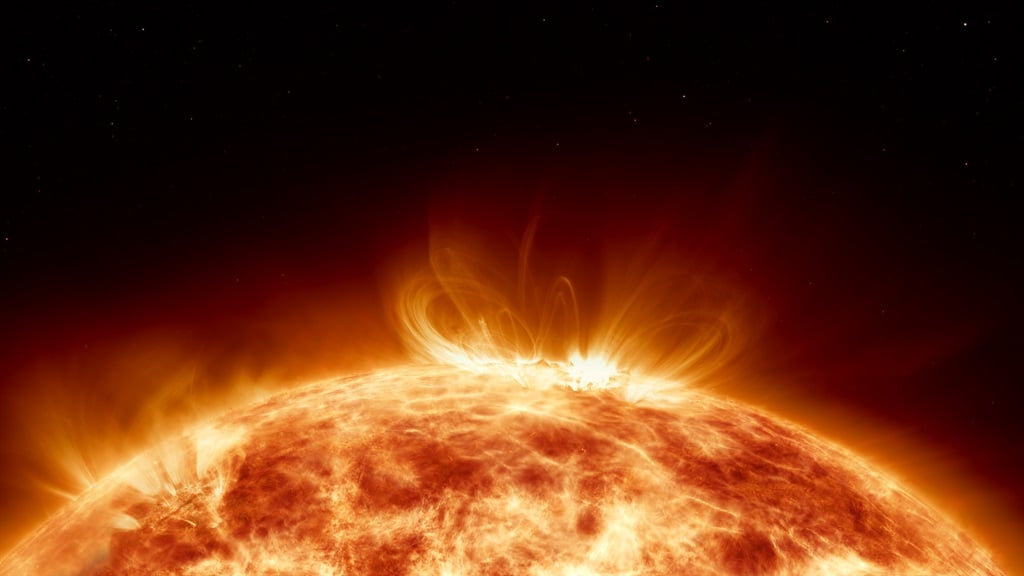
- A severe space weather alert, warning of key grid asset trips and possible widespread voltage control problems, has been issued by the South African space authority.
- This as a G4 geomatic storm forecast was issued by the South African National Space Agency.
- Five eruptions of material from the sun's atmosphere are due to hit earth between Friday evening and Sunday.
- For more financial news, go to the News24 Business front page.
The South African National Space Agency (Sansa) has issued a severe space weather alert, warning of potential key grid asset trips and possible widespread voltage control problems as a solar storm is about to impact with the Earth.
Sansa Space Weather issued a severe G4 geomagnetic storm forecast on Friday Afternoon after spotting three coronal mass ejections earlier this week as well as strong solar flares. The shock wave from the mass ejections are expected to combine before impacting with Earth. This was posted by the agency on X.
Shortly after the post, News24 was sent a media release by Sansa, explaining that there was only a slight chance that the storm will reach G4 levels.
"A G1/Minor up to G3/Strong geomagnetic storm is forecasted to impact Earth due to the likely combination of these CMEs upon arrival. There is a slight chance that the geomagnetic conditions will reach G4/Severe storm levels on 11 May," read the media statement.
The US Space Weather Prediction Center had already issued a G4 geomagnetic storm warning from yesterday.
A coronal mass ejection is the name given to the huge explosions of plasma that erupt from the sun from time to time, which can send charged particles, known as solar wind, towards Earth.
SANSA Update: an X2.3 solar flare is observed from active region 3664 (AR3664). Frequencies of up to 30 MHz in the HF band were affected over the African region. The radio wave absorption was evident on the Hermanus ionogram with no received echoes. Follow us on @SpaceweatherSA pic.twitter.com/Sowwf8ntZ5
— SANSA Space Weather (@SpaceweatherSA) May 9, 2024
Five eruptions of material from the sun’s atmosphere are forecast to arrive, starting late on Friday and persisting through Sunday.
The culprit is a sunspot cluster visible on the right side of the sun’s disc that is 16 times wider than Earth. The sun, which rolls through an 11-year cycle in which the number of spots waxes and wanes, is approaching the peak of the current one that began in December 2019.
Geomagnetic storm conditions previously expected to reach G2/Moderate storm levels are now forecasted to reach up to G4/Severe storm levels! The impact is expected later today into tomorrow 10-11 May. This may impact the performance of navigation and communications applications. pic.twitter.com/aPSOsPDzTD
— SANSA Space Weather (@SpaceweatherSA) May 10, 2024
Sansa has a world-class space weather forecasting station in Hermanus, that has been providing regular updates of new solar activity on X this week.
Sansa initially issued a G2 geomagnetic storm warning which would have signified a risk of triggering voltage alarms at high-latitude power systems and longer-duration storms may cause transformer damage. This is based on a Sansa guide decoding the meaning of different warnings.
The full description of a G4 warning on the Sansa website reads:
Power systems: possible widespread voltage control problems and some protective systems will mistakenly trip out key assets from the grid.
Other systems: induced pipeline currents affect preventive measures, HF radio propagation sporadic, satellite navigation degraded for hours, low-frequency radio navigation disrupted, and aurora has been seen as low at 45° geomagnetic lat..
Geomagnetic storms can impact infrastructure in near-Earth orbit and on Earth's surface, potentially disrupting communications, the electric power grid, navigation, radio and satellite operations.
'Very rare'
This is the first time since January 2005 the US Space Weather Prediction Center has issued a G4 geomagnetic storm watch, the second-highest on a five-step scale, as multiple waves of solar energy bear down on the planet.
"Watches at this level are very rare," the US Space Weather Prediction Centre said.
Earth was hit by a G5 storm, the worst on the scale, in October 2003, which caused damaged transformers in South Africa, and power outages in Sweden.
The storm's true power will be known about 60 to 90 minutes before it hits Earth as satellites measure inbound bursts of energy.
Sansa said it will continue to monitor the situation to help government and the private sector protect infrastructure.
"The sun has an 11-year solar cycle going from solar minimum to solar maximum. We are expecting to reach the solar maximum in 2025. As we move closer to solar maximum, we anticipate an increase in the frequency of space weather events. Sansa will continue to monitor and work with its clients and stakeholders in government and private sectors to ensure that they have access to real time information to best protect their assets," the media statement said.
Additional reporting by Bloomberg.




 Publications
Publications
 Partners
Partners













